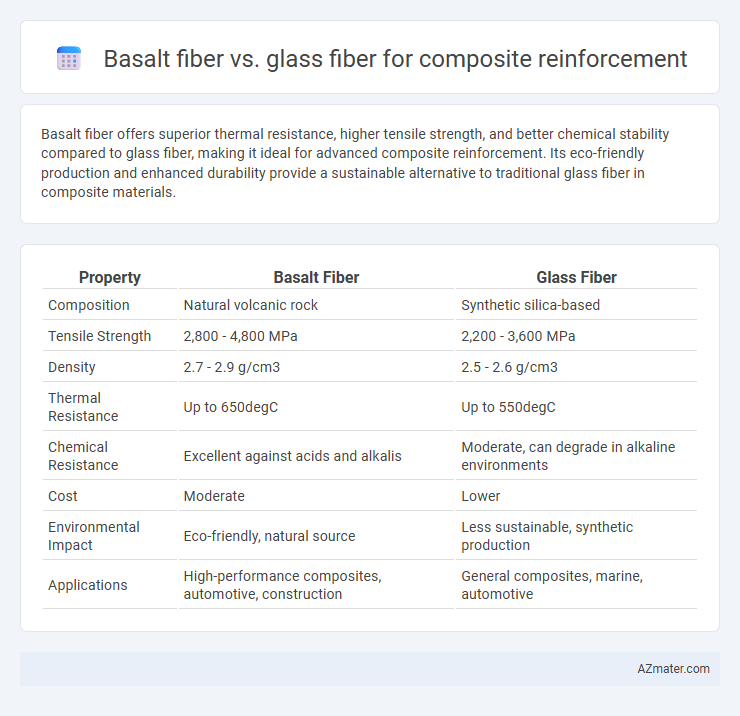Basalt fiber offers superior thermal resistance, higher tensile strength, and better chemical stability compared to glass fiber, making it ideal for advanced composite reinforcement. Its eco-friendly production and enhanced durability provide a sustainable alternative to traditional glass fiber in composite materials.
Table of Comparison
| Property | Basalt Fiber | Glass Fiber |
|---|---|---|
| Composition | Natural volcanic rock | Synthetic silica-based |
| Tensile Strength | 2,800 - 4,800 MPa | 2,200 - 3,600 MPa |
| Density | 2.7 - 2.9 g/cm3 | 2.5 - 2.6 g/cm3 |
| Thermal Resistance | Up to 650degC | Up to 550degC |
| Chemical Resistance | Excellent against acids and alkalis | Moderate, can degrade in alkaline environments |
| Cost | Moderate | Lower |
| Environmental Impact | Eco-friendly, natural source | Less sustainable, synthetic production |
| Applications | High-performance composites, automotive, construction | General composites, marine, automotive |
Introduction to Basalt Fiber and Glass Fiber
Basalt fiber, derived from volcanic basalt rock, offers superior thermal stability, chemical resistance, and higher tensile strength compared to traditional glass fiber, making it a promising material for composite reinforcement. Glass fiber, primarily composed of silica sand and other minerals, is widely used in aerospace, automotive, and construction industries due to its cost-effectiveness, excellent tensile strength, and good corrosion resistance. Both fibers serve crucial roles in enhancing composite materials, but basalt fiber's eco-friendly production and durability under extreme conditions position it as a strong alternative to glass fiber in advanced applications.
Production Processes and Raw Materials
Basalt fiber is produced by melting crushed basalt rock at temperatures around 1400degC, resulting in natural volcanic glass fibers with high tensile strength and excellent chemical resistance. Glass fiber manufacturing involves melting silica sand mixed with other raw materials like limestone and soda ash, typically at higher temperatures near 1700degC, yielding versatile fibers widely used for reinforcement. The basalt production process is more environmentally friendly due to the use of abundant natural rock without additives, whereas glass fiber requires more energy-intensive melting and chemical additives.
Mechanical Properties Comparison
Basalt fiber exhibits higher tensile strength and better abrasion resistance compared to glass fiber, making it more suitable for demanding composite reinforcement applications. Its superior thermal stability and chemical resistance enhance durability in harsh environments, outperforming traditional E-glass fibers in mechanical load-bearing capacity. Weight-to-strength ratio also favors basalt fiber, providing lightweight composites without compromising structural integrity.
Chemical Resistance and Durability
Basalt fiber exhibits superior chemical resistance compared to glass fiber, maintaining structural integrity in acidic and alkaline environments commonly encountered in industrial applications. Its enhanced durability against environmental degradation results from a higher resistance to moisture absorption and thermal stability, extending the service life of composite materials. Glass fiber, while cost-effective and widely used, is more susceptible to chemical attack and often requires protective coatings or treatments to enhance longevity in harsh conditions.
Thermal Stability and Heat Resistance
Basalt fiber exhibits superior thermal stability and heat resistance compared to glass fiber, maintaining structural integrity at temperatures up to 600degC, while glass fiber typically withstands up to 450degC. The higher melting point and better thermal insulation properties of basalt fibers make them ideal for high-temperature composite reinforcement applications. Enhanced resistance to thermal degradation ensures longer service life and reliability of basalt fiber-reinforced composites in extreme heat environments.
Environmental Impact and Sustainability
Basalt fiber offers superior environmental benefits over glass fiber due to its natural volcanic rock origin, which requires less energy for production and emits fewer greenhouse gases. Unlike glass fiber, basalt fiber is non-toxic, recyclable, and biodegradable, enhancing sustainability in composite reinforcement applications. The durability and corrosion resistance of basalt fiber also prolong the lifespan of composites, reducing material waste and promoting a circular economy.
Cost Analysis and Market Availability
Basalt fiber generally offers a competitive cost advantage over glass fiber in composite reinforcement due to lower raw material and energy consumption during production. Market availability of glass fiber remains higher, supported by established manufacturing infrastructure and extensive supplier networks, making it more accessible for large-scale applications. However, basalt fiber's growing market presence is driven by its superior mechanical properties and environmental benefits, potentially influencing future cost dynamics and supply expansion.
Applications in Composite Reinforcement
Basalt fiber offers superior chemical resistance, higher tensile strength, and better environmental durability compared to traditional glass fiber, making it increasingly favored in composite reinforcement applications such as automotive components, aerospace structures, and construction materials. Its excellent thermal stability and corrosion resistance enable extended service life in harsh environments, outperforming E-glass fibers in marine and industrial composites. Glass fiber remains a cost-effective choice for mass-produced composite parts, but basalt fiber's enhanced mechanical properties drive its adoption in high-performance and sustainable composite reinforcement solutions.
Performance in Real-World Structures
Basalt fiber offers superior thermal stability and chemical resistance compared to glass fiber, making it ideal for composite reinforcement in harsh environmental conditions. Its higher tensile strength and better impact resistance enhance durability in real-world structures such as bridges and automotive components. Glass fiber remains cost-effective and widely used but may suffer from lower corrosion resistance and mechanical performance under prolonged stress.
Future Trends and Innovations
Basalt fiber demonstrates superior thermal stability, higher tensile strength, and enhanced environmental resistance compared to traditional glass fiber, positioning it as a leading material in next-generation composite reinforcement. Innovations in hybrid composites integrating basalt fiber with nanomaterials aim to improve mechanical properties and corrosion resistance for automotive and aerospace applications. Ongoing research focuses on scalable production techniques and eco-friendly recycling methods to meet the increasing demand for sustainable and high-performance composite materials.

Infographic: Basalt fiber vs Glass fiber for Composite reinforcement
 azmater.com
azmater.com